
- Source: The Paris Review
- Author: Chantal McStay
- Date: August 29, 2017
- Format: PRINT AND DIGITAL
I ♥ John Giorno
and So Should You
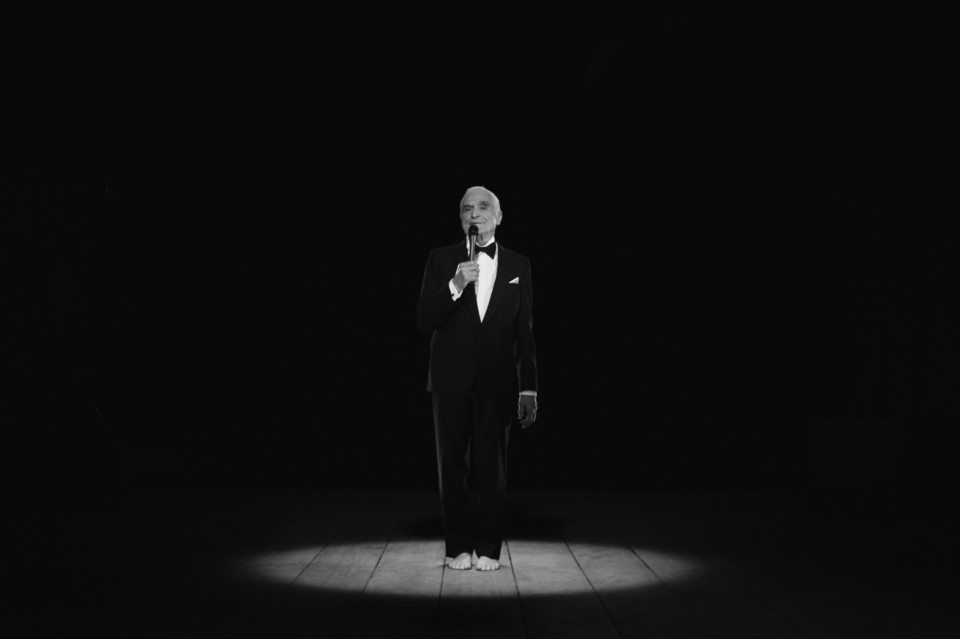
Ugo Rondinone, THANX 4 NOTHING, 2015, Multichannel film installation.
In any given decade of his life in New York, John Giorno could be found right in the middle of whatever the new scene might be, hanging out with the era’s defining figures and embodying the moment: in the fifties, meeting Jack Kerouac at Columbia’s West End; in the sixties, making a movie with Andy Warhol; in the seventies, studying Buddhism in India; in the eighties, playing in a band at CBGB. He has always been a poet who operates primarily in the art world. His practice is multimodal and collaborative: he’s experimented with sound recording, painting, video, and has been muse and lover to a number of artists, including Warhol, Robert Rauschenberg, and Jasper Johns. This last detail, which is so often salaciously foregrounded in the literature and mythos surrounding Giorno, would appear to put him in a passive or sidelined role, but his work gleefully subverts this, showing just how potent and active these roles can be. It reveals, too, the advantages of having passed the time with great artists and what he has learned from being the subject of their gaze.
“I ♥ John Giorno,” Ugo Rondinone’s exhibition-as-artwork love letter to his husband and collaborator, which appeared at the Palais de Tokyo in 2015, has come home to New York this summer. This iteration requires a peripatetic tour of thirteen independent and nonprofit venues throughout the city. Rondinone, Giorno’s partner of eighteen years, explores nine distinct chapters in Giorno’s diverse body of work and interweaves portraits of and responses to the poet by filmmakers, painters, videographers, and musicians of many generations. I spent five days taking in the show and feel as if I’ve only begun to traverse Giorno’s staggering creative output, as intricate as it is wide-ranging.
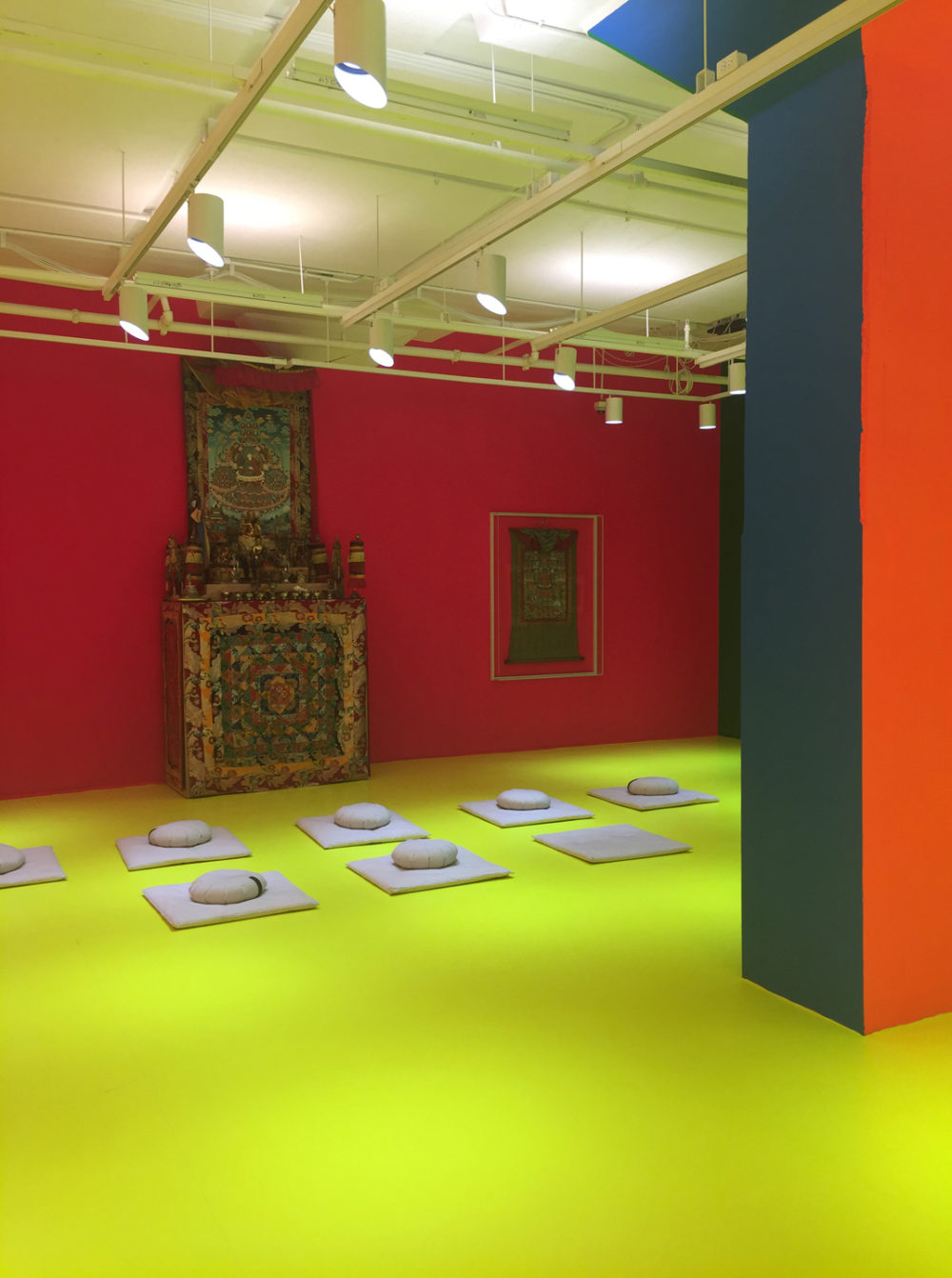
205 Hudson Gallery
In 1971, inspired by a post-LSD conversation with Allen Ginsberg, Giorno traveled to India to study Buddhism. There, he met HH Dudjom Rinpoche, the supreme leader of the progressive Nyingma school of Tibetan Buddhism, and became a devoted student. (Giorno’s poem “Guru Rinpoche” was published in the Review in 1972.) The gallery at 205 Hudson presents two facets of Giorno’s practice: Buddhist loving kindness and the AIDS Treatment Project, which he founded in 1984. Surrounding Giorno’s personal shrine are Tibetan Buddhist tapestries on loan from the Rubin Museum, many depicting Padmasambhava, an eighth-century Indian Buddhist master “whose main means of overcoming any obstacle was to transform it into an ally.” For the AIDS Treatment Project, a grassroots program that collects funds and gives them directly to AIDS patients, Giorno approached his philanthropic efforts with compassion and a do-what-you-can, do-it-yourself attitude:
My intention is to treat a complete stranger as a lover or a close friend; in the same spirit as in the golden age of promiscuity, we made fabulous love with beautiful strangers, and celebrated life with glorious substances. ‘God please fuck my mind for good!’ Now that their life is ravaged with AIDS, we offer love from the same root, in the form of boundless compassion.
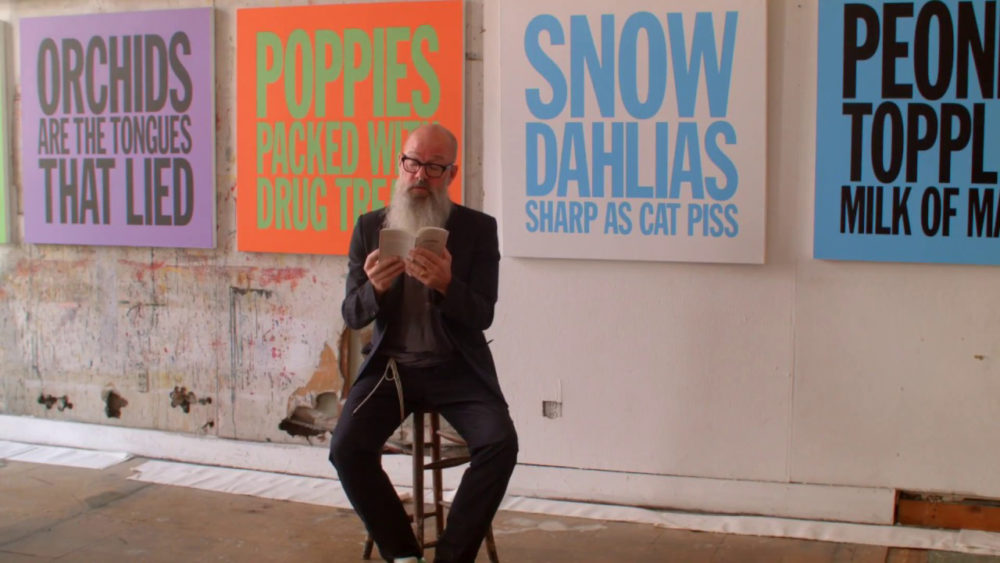
Artists Space
If you visit only one portion of “I ♥ John Giorno,” go hear Giorno read in person. The series, curated by Harry Burke, brings together John, his contemporaries, and a new generation of poets inspired by his work. The final reading of the series—on August 31, on the roof of NYU’s Kimmel Center—will feature poetry and performance by Anne Waldman (accompanied by Devin Brahja Waldman), Miguel Gutierrez, Kevin Killian, and Angel Nafis, along with a video work by Joan Jonas.
Giorno opened the series on June 23 by reading with Fanny Howe and Mónica de la Torre (coeditor of the June edition of The Brooklyn Rail, which serves as the exhibition’s catalogue). De la Torre performed two of her own poems that include subway sounds and the meditative tones of a Buddha Machine and an occasional poem that she reads against a recording of her own voice—nods to Giorno’s sound poem “Subway,” his practice of Tibetan Buddhism, and his work with synthesizer inventor Robert Moog, respectively. Howe read “Wide Steps Up,” dedicated to Giorno:
One pilgrim wears a beard
Down to his chest
But love hates coverings.
And prefers to be seen and, if despised,
To melt away quickly.
Giorno read his new fable poem “Wish-Fulfilling Jewels & the Poet,” about a thirteenth-century ancestor who was a priest in a Romanist church and the weight of his bejeweled vestments, which inspire lust and greed as he preaches the gospels. When Giorno reads, he leans forward into the audience, his lilting Brooklyn accent thumping through the room as his heels lift off the ground. I think his toes will lift up next, until a repeating section grounds him:
I am a complete failure
I am a complete failure.
I am just a devil making more devils.
His fable admits futility, showing how scary and thrilling it is to be alive, how alone one is, even among people, how infuriating it is to say “I,” to admit this loneliness and how hard it is to bridge this gap. When talking about stage presence, we often think in terms of confidence and control, yet Giorno’s performance style comes from a place of radical humility, of practice and repetition that goes beyond recitation.
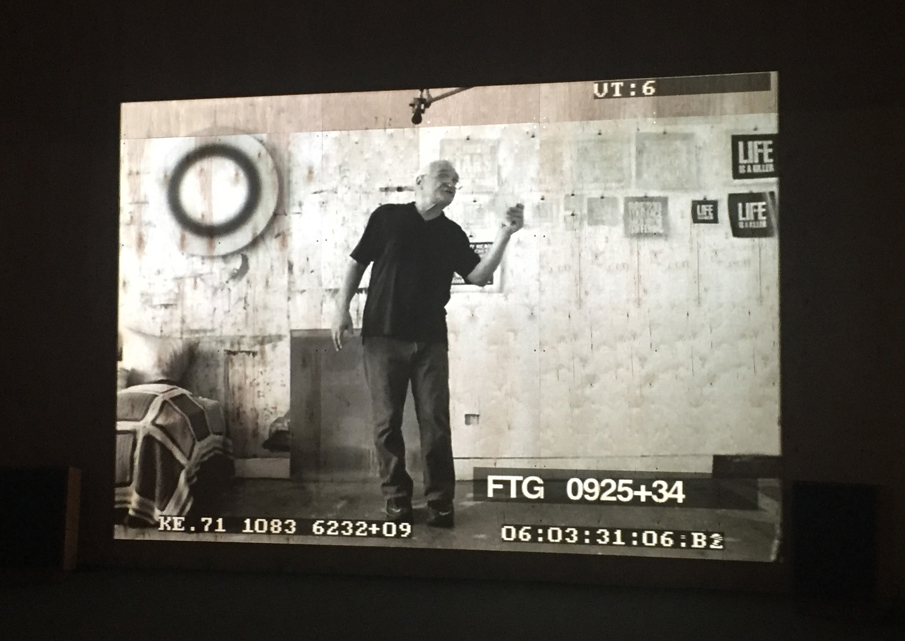
The Kitchen
I sit on a wooden bench across from a projection of a life-size Giorno, filmed in a replica of his studio in 2008. The Kitchen features a silk-screen work by Joan Wallace and photographs by Françoise Janicot, but the centerpiece is here, inside a wooden dwelling constructed by Rirkrit Tiravanija, where you can watch Giorno perform every poem he ever wrote, for over ten hours. After each poem, he takes a tiny bow. Sometimes he puts one of the Giorno Poetry Systems Records on and walks out of the shot. Many poems are capsules of particular encounters, recounting first meetings with his artistic heroes: Ginsberg, Kerouac, Keith Haring. Giorno has an uncanny sense of the larger meaning of the moment while the moment is still occurring, and this comes through in the immediacy of his poems, which are not nostalgic. There is a lulling quality to the repetitions out of which his poems are made; the longer you listen, the deeper into the hum you go. When I finally stood up from the pine bench (custom-made by Mark Handforth), two hours had passed.
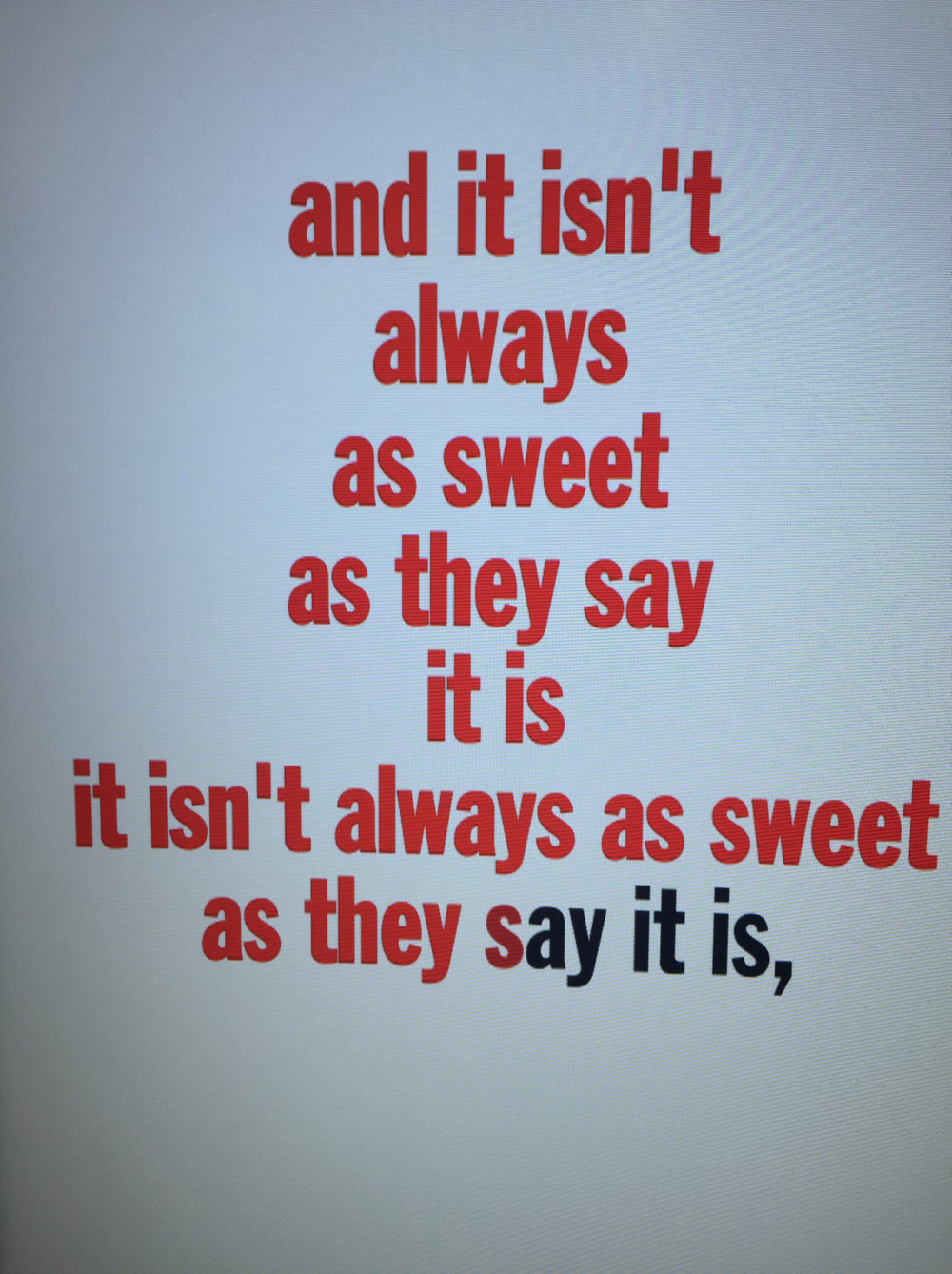
Red Bull Arts New York
Over a dozen glowing white LCD screens greeted me here, each blinking verses from Giorno’s poetry, bopping along like karaoke videos accompanying audio recordings of Giorno performing the poems, his voice multiplied to trippy effect. He was first introduced to sound poetry by Brion Gysin in the sixties: many of Gysin’s poems treat word combinations as permutations, cycling and repeating, pushing on the boundaries of what makes a poem not an intentional arrangement of words and sounds but a randomized occurrence. Giorno’s sound poems here are poem paintings brought to life, bouncing and talking: “I cashed in on the bliss / I cashed in on the bliss.” Giorno’s voice slows and takes on an almost Southern cadence; the reverberation and distortion, both aural and visual, renders phrases, words, sounds mysterious. Downstairs in the gallery is a kitschy merch table (an installation by Scott King) full of Chinatown stall–style “I ♥ John Giorno” paraphernalia—teddy bears, thong underwear, pillboxes. On the other side of the room, headphones dangling from pipes in the ceiling play tracks from John Giorno Band, which was active from 1982 to 1989. The songs repurpose lines I love from his poetry and sound work, but somehow turning them into lyrics for catchy but conventional rock tunes doesn’t feel as fresh as the other innovations of language and sound on offer here.
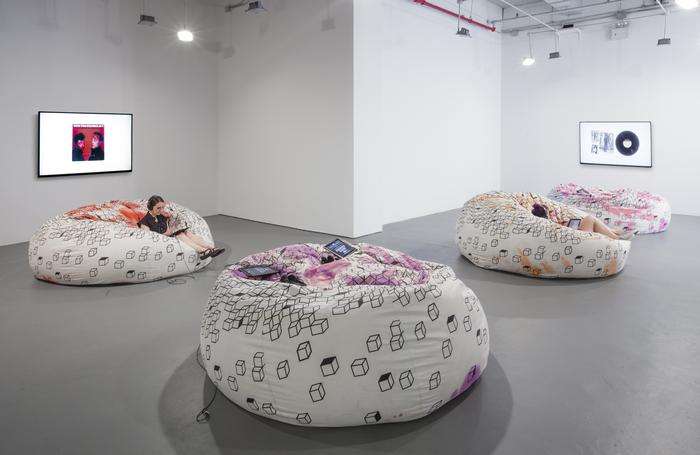
White Columns
Angela Bulloch created Happy Sacks: big, huggy beanbags on which to lounge while listening to the catalogue of Giorno Poetry Systems, the collective record label that produced more than fifty records from 1972 to 1993, documenting innovative performances from poets, artists, performers, and musicians, and attempting to bridge the technological gap between poetry and other art forms. Slumped on a giant beanbag, headphones on, armed with an iPad, I feel like I’m in the office of the start-up from Girls, but the moment I hit play, I’m far away.
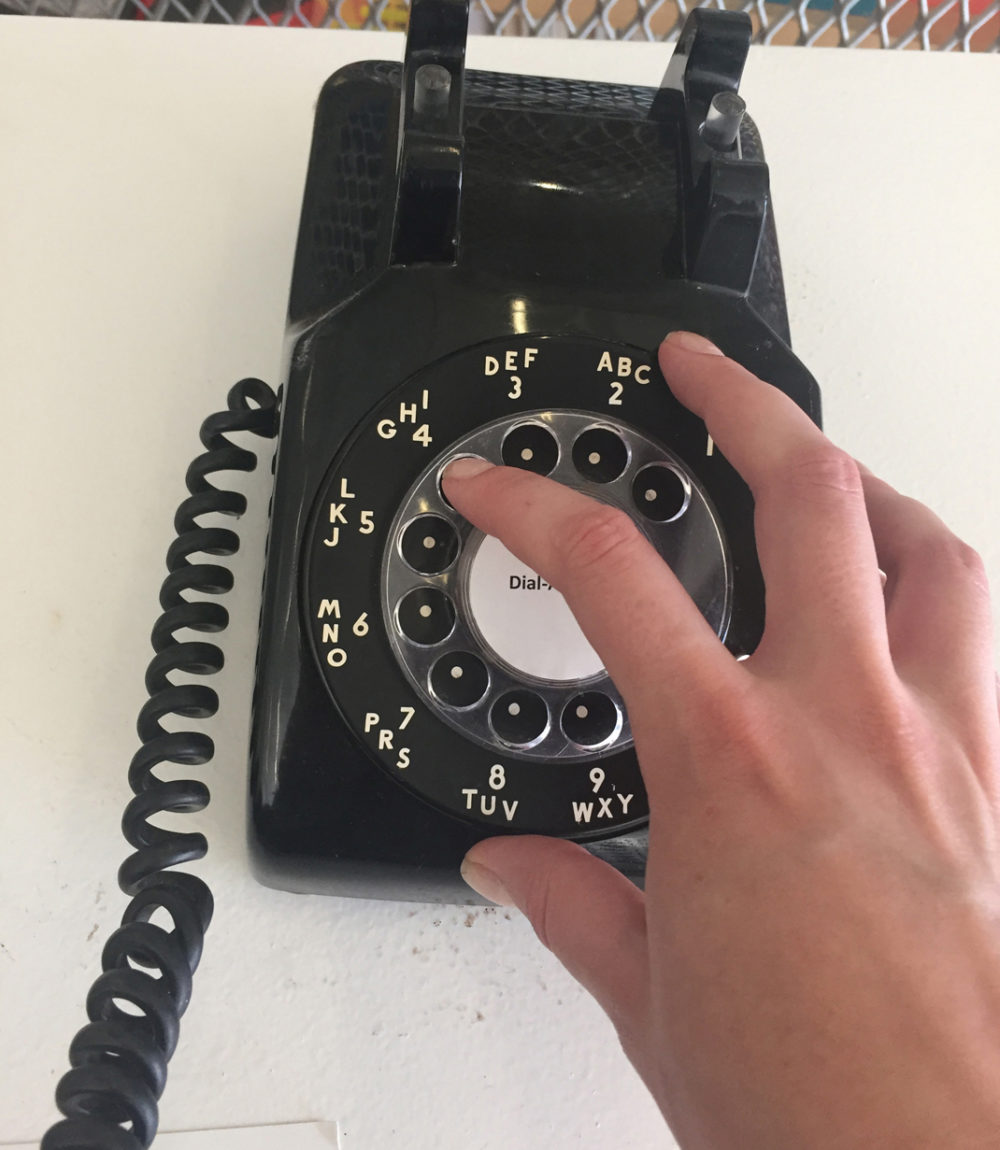
New Museum
When I pick up the Dial-A-Poem telephone installed in the lobby here, I hear John Cage reading from his “45’ for a Speaker.” As I listen, I look out onto the Bowery at the restaurant-supply stores and imagine John Cage at the other end of the phone reading just for me. I can almost hear him lean on his elbow (as instructed in the piece) before he whistles three times: “The control must be at one point only and so / placed that it has no effect on anything that / happens: A technique which results in no technique, etc.” The black rotary phones are located at several of the stations of the exhibition, but they’re really just for show—you can call the revived Dial-A-Poem from anywhere at 1-641-793-8122 and hear Giorno introduce one of the dozens of poets who participated in the project—Ginsberg, Anne Waldman, Vito Acconci, John Ashbery—before his or her voice comes on the line. The original iteration ran on ten telephone lines for five months in 1968; more than a million calls were received. Dial-A-Poem brought poetry out of traditional venues for a privileged few and into everyday life. It also put the listener in an active role, as the caller, rather than as a passive recipient of verse. I keep calling back, hoping to hear the one by Aram Saroyan again, about what makes a poem. Saroyan says he never knows how to answer that question.
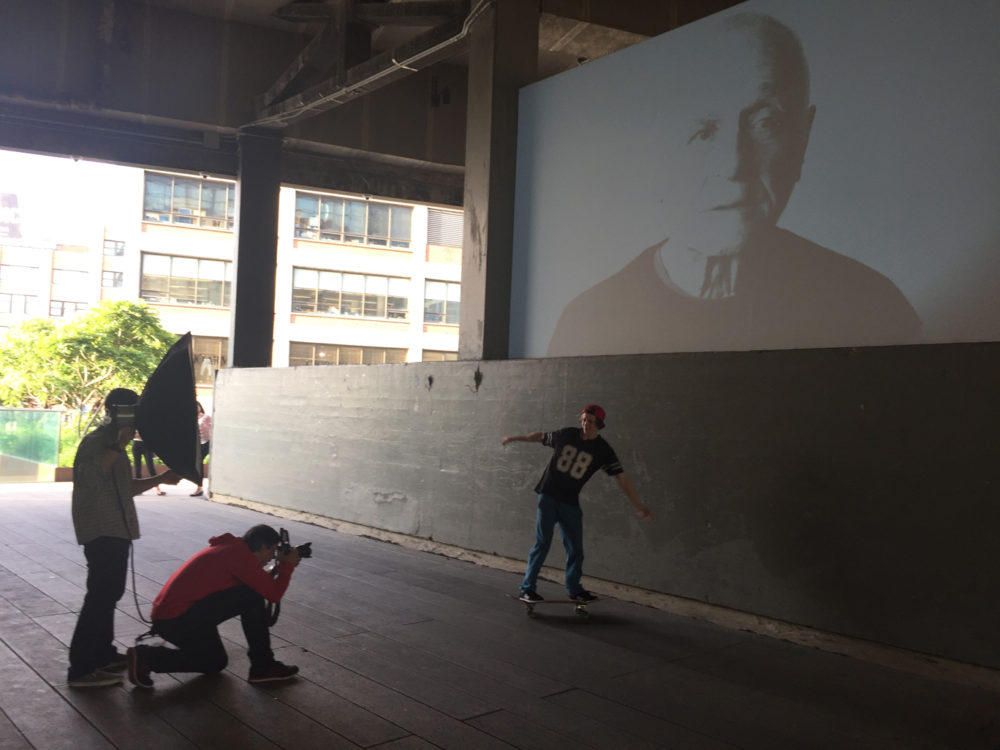
The High Line
A high school–themed fashion photoshoot is going on under the Fourteenth Street Passage where Michael Stipe and Dominic De Joseph’s Warhol screen test–inspired music video for “We All Go Back to Where We Belong, John” (2011) is being projected. First, a skateboarder scuttles back and forth. Then the photographer calls in a new group: “Nerdy girls, come on, sexy librarian vibe.” A nearby street musician plays an erhu, nearly concealing the faint sounds of Stipe’s singing. In the video, Giorno looks on with a mix of amusement and slight embarrassment. His reaction could correspond to just about any element of the dependable din generated in this echoey covered portion of the High Line, crowded with street vendors, shoppers, tourists, power lunchers—performers of all kinds. Giorno is natural and generous in front of the camera. In a simple, quiet video portrait, overlooking a busy New York City public park, his presence is unsurprising, inevitable; he belongs.
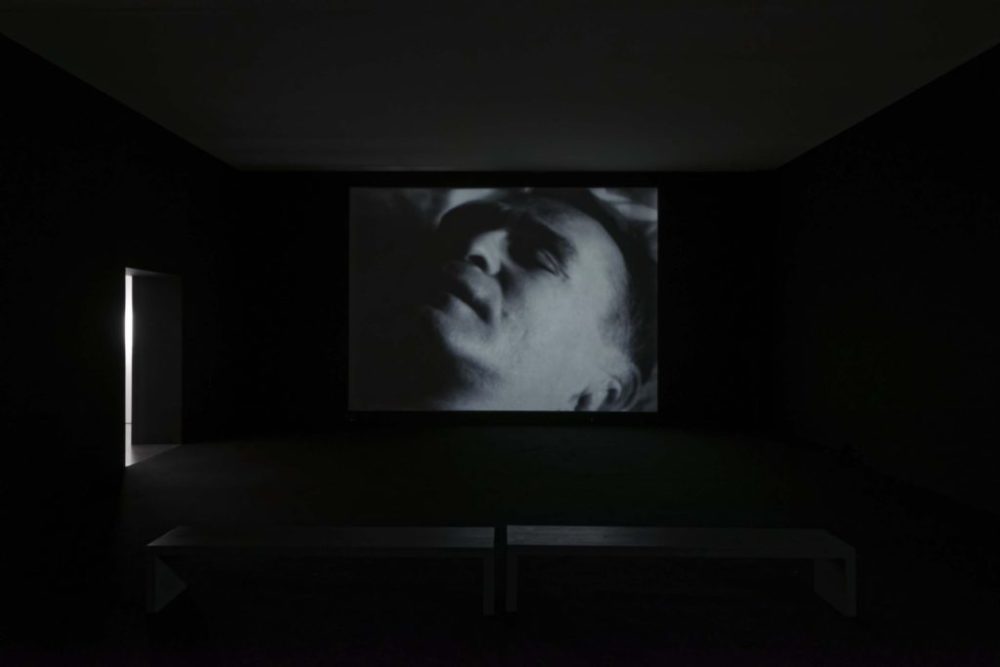
Howl! Happening
It may not make sense to see the remake before the original, but this pops up first on my route south from Washington Square Park. Giorno chatters from a speaker directly overhead, active, antsy even, in contrast with his sleeping body on-screen in Sleeptalking, Pierre Huyghe’s 1998 re-creation of Warhol’s Sleep. Giorno can’t stop talking, darting from topic to topic. He talks over Huyghe’s movie of him sleeping—that’s the movie. Amid anecdotes about working with Warhol and others are bits of wisdom: “I just followed the lead of all of the painters and sculptors and dancers: do it yourself. The whole guiding principle is that nobody is going to do it for you, you’ve gotta do it for yourself.” Giorno may have been asleep while working with Warhol, but he soaked up the artist’s freedom of approach and collaborative methods. He brought excitement and personality and sex to the staid tradition of the stuffy poetry reading. He did it by doing it himself: hosting his own readings, making his own recordings, starting his own label.
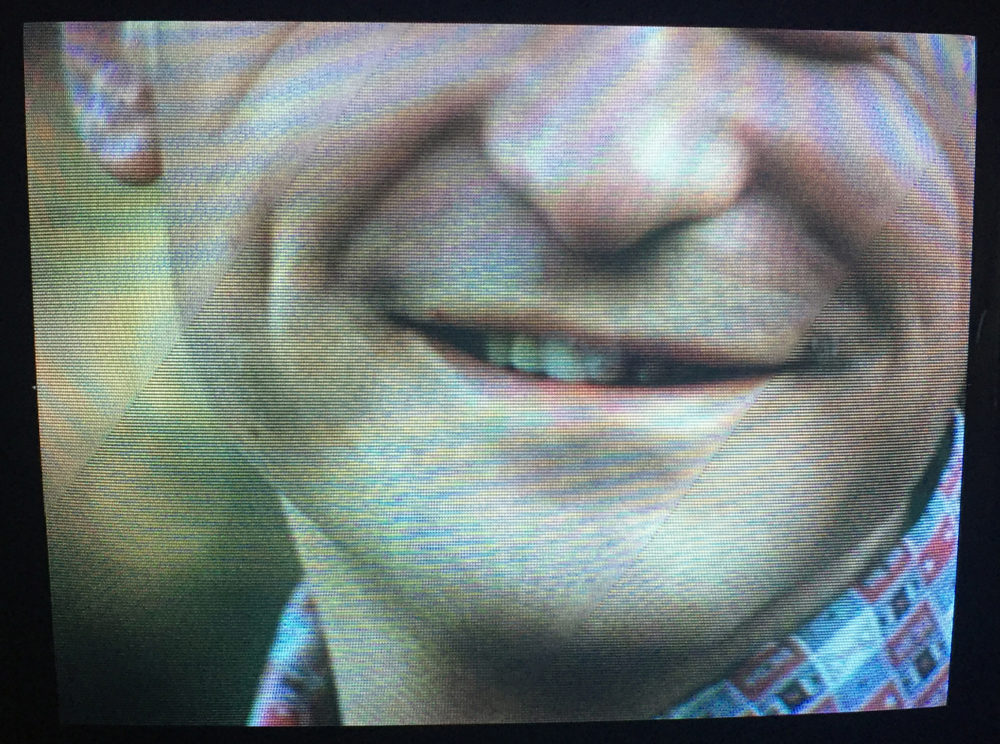
Swiss Institute / Contemporary Art
Nine television sets playing unreleased film portraits of Giorno by Warhol flank a big-screen projection of Sleep. I can’t stop watching a three-minute loop of Giorno with Wynn Chamberlain, Robert Indiana, Eleanor Ward, and Marisol at a garden party. All of these proto screen tests are slowed down to twenty-four or sixteen frames per second, and I notice the subtlest crinkles and gestures. I can almost see the questions on the subject’s lips: What is this for? What am I supposed to be doing? But Giorno doesn’t quite look at the camera. Whether laughing or, as in another film, washing the dishes in the nude, he’s cool before the camera. He looks good, and he knows it.

Bertha and Karl Leubsdorf Art Gallery
Butt crack. Arched back. Striking a Vitruvian pose. John danced for Kendall Shaw in 1963. The spare nude silhouettes and body contours Shaw painted based on photographs he took of that 1963 encounter find Giorno in a familiar role as model and muse. Here for the first time, the original photos are exhibited with the paintings.
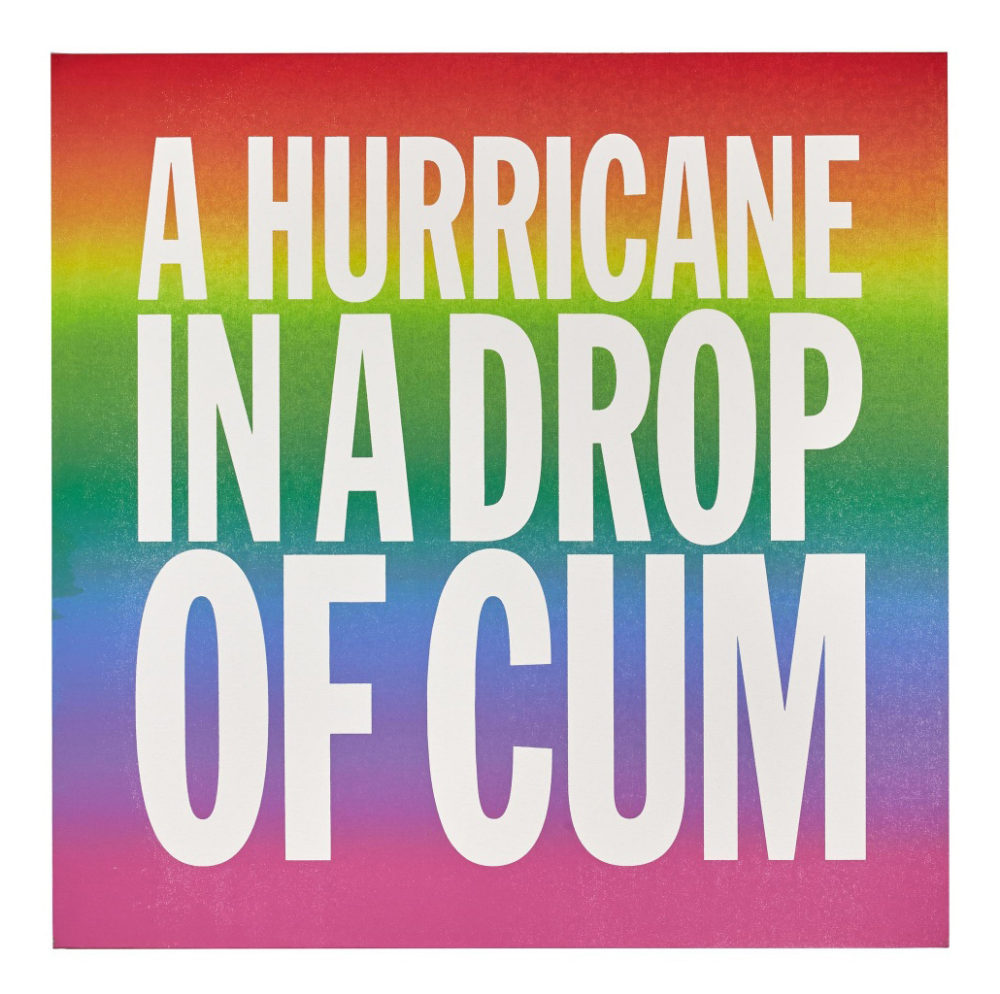
80 WSE Gallery—Broadway Windows
I first spotted these rainbow-backdrop poem paintings one evening after catching the stylish but rather disappointing remake of The Beguiled, and they cheered me right up. It inspires no small amount of glee to see A HURRICANE IN A DROP OF CUM announced on Tenth and Broadway with the same block-letter importance as WELLS FARGO and CHASE. Giorno has been silk-screening key phrases from his poems arranged in perfect block columns for decades. They operate more like slogans or mantras than concrete poems.
JUST SAY NO TO FAMILY VALUES
BAD NEWS IS ALWAYS TRUE
The bold all-caps act as a strange camouflage, blending with the exclamatory typography of surrounding signs and advertisements; the eye expects the same feigned urgency of the mundane messaging seen everywhere, but finds something unexpectedly funny and profound.
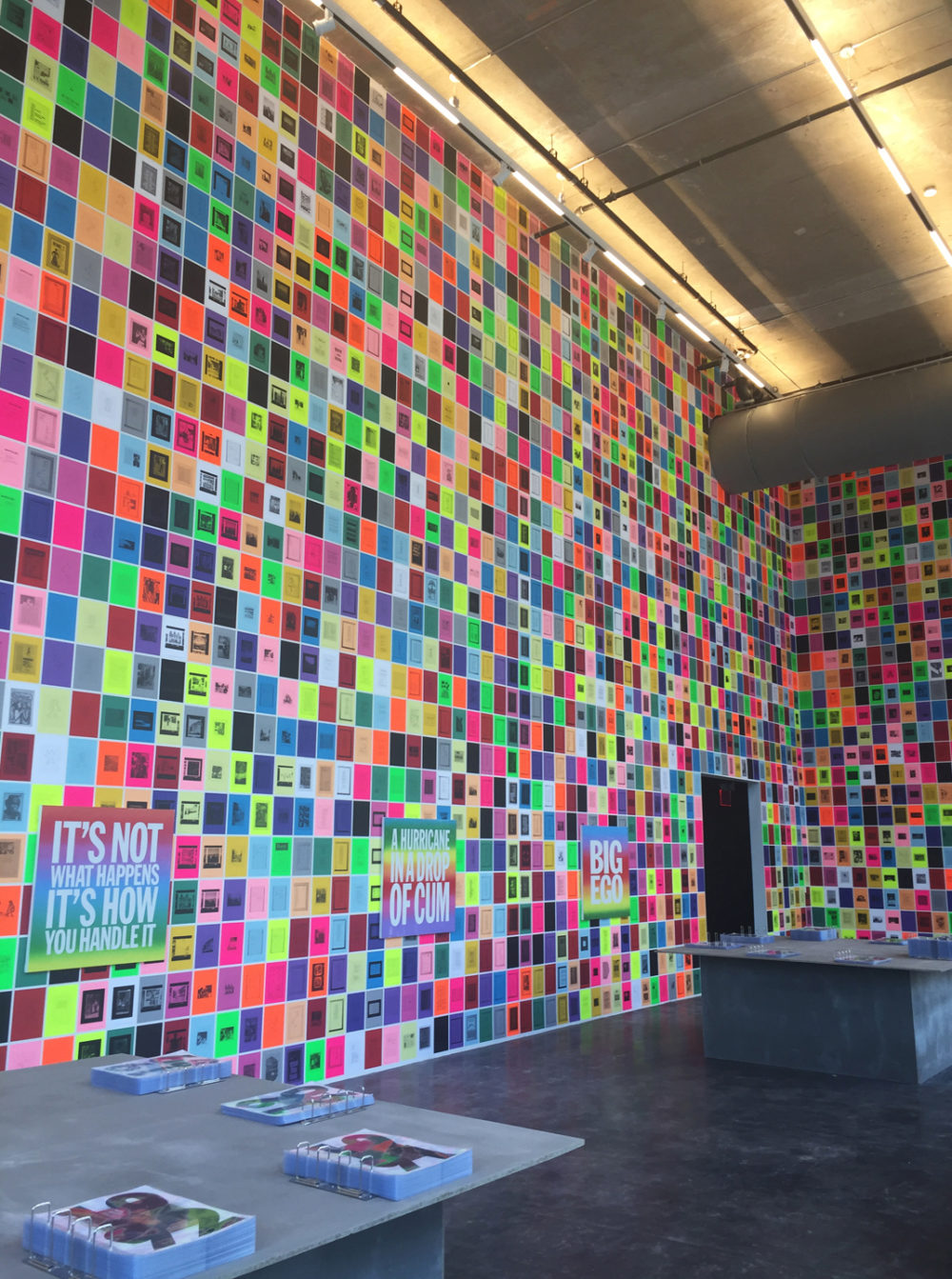
Sky Art
The thirty-foot walls of this new exhibition space in far west Midtown are plastered with neon copies of papers from Giorno’s archive, like rows of prayer flags. Rondinone calls this archival wallpaper the sky over manhattan. I start to flip through the binders in the room: there are eighty, one for each year of the poet’s life, together containing more than fifteen thousand items—intimate snapshots, early reviews, drafts. High school classmates know John will be a famous poet and tell him so when they write in his yearbook. John knew it, too. He started accumulating documents for his archive in the midforties and got serious about it in the early sixties, inspired by Ginsberg and others who had already sold portions of their personal papers. Giorno’s archivist, Marcia Bassett, who selected some of her favorite pieces from the collection, points to the many Les Levine–designed album covers and fliers for Giorno Poetry Systems, such as a 1979 trifold mailer for The Nova Convention LP, which raises spoken-word performances and recordings to the level of rock-and-roll glory, though not without smirking at rock-promo conventions. A star-burst badge, for instance, certifies SOLID GOLD POETRY.
Sky Art also houses THANX 4 NOTHING, Rondinone’s 2015 multivideo installation of a tuxedoed Giorno performing his poem of the same name, written on the occasion of his seventieth birthday, in 2006. Eleven years later, situated among his papers, these words rattle:
I want to thank you for taking everything for yourself
and giving nothing back,
you were always only self-serving,
thanks for exploiting my big ego
and making me a star for your own benefit
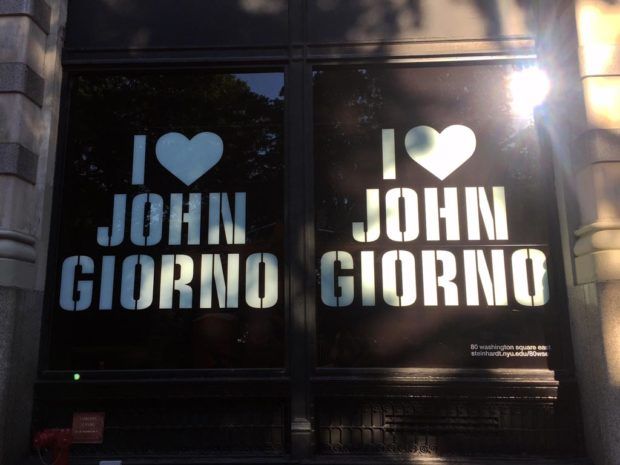
80 WSE Gallery—Washington Square Windows
Scott King’s graphic identity for the retrospective, displayed here and at other sites, recalls Milton Glaser’s iconic I ♥ NY and all the ubiquity, repeatability, and multiplicity of meaning that relentlessly reproduced piece of design has come to signify. To ♥ New York is to love it in an epicurean way, with one’s whole body, to accept its flaws, to revel in its sensory overload, to become accustomed to the unexpected. It’s a lot like ♥ing Giorno, whose work sets out to provoke and engage, to turn a passive viewer or listener into an active participant, a maker and a doer—hearting, helping, dialing, laughing. I ♥ John Giorno is itself a repeating mantra. Who is I? It’s Ugo, it’s JG’s many collaborators, it’s us.
Chantal McStay is a writer and editor in New York. She is currently an Andrew W. Mellon fellow at BOMB Magazine.

